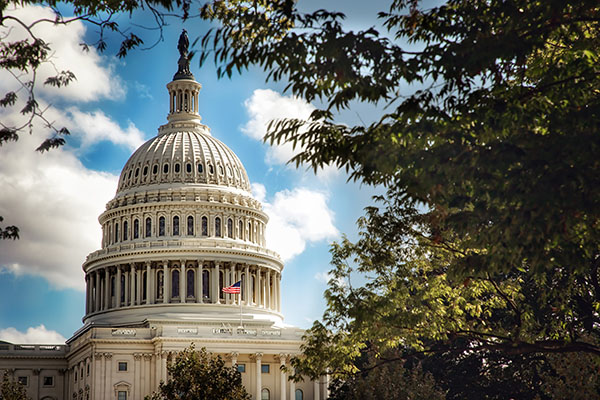Momentum for some infrastructure spending building on Capitol Hill
Infrastructure is having a good month in Washington. Lobbyists and lawmakers are eagerly optimistic about a bill coming out of Congress this year. And President Donald J. Trump talked up infrastructure a bit during his State of the Union address.
Infrastructure is having a good month in Washington. Lobbyists and lawmakers are eagerly optimistic about a bill coming out of Congress this year. And President Donald J. Trump talked up infrastructure a bit during his State of the Union address.
Trump, without offering any specifics, said he would be “eager” to sign a bill that would help repair “our crumbling infrastructure.” That was music to the ears of those who have been calling for increased federal spending on roads, bridges, highways, ports and airports.
But so far on infrastructure Trump has been all words and no action. He once vowed a $1.5 trillion infrastructure bill. But so far under his watch, Congress has allocated barely $21.2 billion—barely 1 percent of what he once touted.
Will this year be any different? Who knows? But Washington lobbyists are lining up in support already.
Following the State of the Union address, American Trucking Associations’ President and CEO Chris Spear praised the president for his proactive calls to address the nation’s aging infrastructure and modernize our trade relationships with our North American neighbors.
“President Trump called for a national, bipartisan effort to restore our country's declining infrastructure—and America's truckers are answering that call,” Spear said. “A win on this issue will require real investment, not budgetary gimmicks as tried in years past. That is why America's truckers, along with a broad coalition of the business community, have pledged our financial commitment to making this national priority a reality.
Spear said “decades of failed leadership in Washington have led us to this point, which is why we commend the President for seizing this opportunity to bring all sides together to forge a common path forward.
“Restoring our national infrastructure to greatness will further ignite our economy, make us more competitive abroad, and give Americans more time to spend with family and less time stuck in traffic,” Spear added.
U.S. Chamber of Commerce President and CEO Thomas J. Donohue, who has been relentless in his plea to tax motorists a bit more to pay for improved infrastructure, again is renewing his pledge that the business community needs more spending on highways and bridges to get their products to market.
“You don’t have to be a civil engineer to know that our nation’s infrastructure is falling apart,” Donohue wrote in a blog post. “All you have to do is leave your house. The evidence is everywhere – and affects everyone.”
The average American loses 42 hours stuck in traffic each year. Meanwhile, U.S. airports and an antiquated air traffic control system cost the U.S. $9 billion annually in productivity from flight delays. Interstate highways, developed in the 1960s, are congested. Inland waterways are operating with 100-year-old locks and dams.
The economic toll of our crumbling infrastructure is steep and rising still. By 2025, it will have cost businesses $7 trillion, according to Donohue.
The Chamber of Commerce held an “Infrastructure Summit” on the day Trump spoke to the nation to encourage Congress to move now on bipartisan legislation to revitalize the physical platform of our economy.
“The first step in fixing our infrastructure is ending the gridlock in Washington,” Donohue said. “We need to build bridges across the political divide before we can build bridges around the country.”
National Association of Manufacturers (NAM) President and CEO Jay Timmons said U.S. industry is coming off the “best year for manufacturing job creation in more than two decades.”
He added in 2018 the NAM’s Manufacturers’ Outlook Survey found the highest level of optimism among manufacturers in the survey’s 20-year history.
“The strength of our union is found in modern manufacturing, so President Trump was right to keep his focus on the men and women who make things in America,” said Timmons.
The Chamber and other Washington lobbyists say a meaningful infrastructure proposal should include four fundamental pillars:
- A long-term, sustainable funding source to repair our roads, bridges, and transit systems. The simplest solution is a modest increase to the federal fuel user fee—currently 18.4 cents a gallon gasoline and 24.4 cents gallon on diesel, unchanged since 1993;
- Second, the U.S. needs innovative financing solutions to pay for major critical infrastructure projects, including public and private funding;
- Permanently streamline the permitting process so that projects don’t take longer to approve than to build; and
- Finally, make sure the country has the skilled workers ready to take on new projects.
The Coalition for America’s Gateways and Trade Corridors (CAGTC) urged the Administration and Congress to unite in the coming months on infrastructure—what it called “a bipartisan bright spot”
“Infrastructure investment is a bipartisan issue at its core,” said CAGTC Executive Director Elaine Nessle. “For too many years, federal freight infrastructure investment has lagged while our population and national economy grow.”
This financial burden cannot be shouldered by states, localities and the private sector alone, Nessle added.
“There needs to be a commitment to driving an investment plan at the federal level,” Nessle said. “Existing programs are oversubscribed and international trading partners are outpacing our investments at a rapid clip – increased funding dedicated to freight infrastructure is necessary in order for the U.S. to remain competitive in the world marketplace.”
The U.S. freight system moves 55 million tons of goods daily, worth more than $49 billion.
That’s roughly 63 tons per person annually; meanwhile, the U.S. population is expected to increase by 70 million by 2045. Freight movement across all modes is expected to grow nearly 42 percent by 2040.
“To capitalize on this growing consumer base, our infrastructure network must be up for the task,” Nessle concluded.













